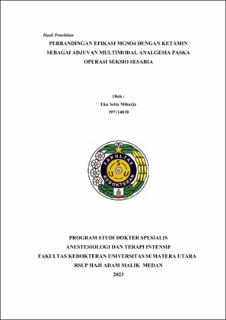Perbandingan Efikasi MGSO4 dengan Ketamin sebagai Adjuvan Multimodal Analgesia Paska Operasi Seksio Sesaria

Date
2023Author
Miharja, Eka Setia
Advisor(s)
Ihsan, Mhd
Wijaya, Dadik Wahyu
Metadata
Show full item recordAbstract
Introduction :Abdominal pain after sectio cesarean appears to be a significant
problem but is quite variable, various analgesia modalities are known to be used
for postoperative analgesia. One of them is ketamine and magnesium sulfate
which are often used as additional post-operative analgesics.
Method :This research is a Randomized Control Trial (RCT) study carried out at
the Haji Adam Malik Medan Central General Hospital and the Medan Haji Hospital
in August-September 2023. The sample is pregnant patients who will undergo
caesarean section surgery under spinal anesthesia. The study was divided into 3
groups, MgSO4, ketamine, and control. All groups received the same preoperative
and intraoperative treatment. In the postoperative period, the MGSO4 group
received an infusion of MgSO4 20 mg/kg/hour, the ketamine group received an
infusion of ketamine 0.2 mg/kg/hour for 12 hours. Then, the postoperative pain
scale and treatment side effects were assessed at the 0th (T0), 6th (T1), 12th (T2),
and 24th (T3) hours.
Results :The research consisted of 30 samples, namely 10 samples per group.
Based on the rest and activity pain scales, a statistically significant difference was
found at the 12th hour and 24th hour of monitoring, p<0.05. Meanwhile, in
hemodynamic changes during monitoring, there were no significant differences in
changes in MAP and heart rate during the entire monitoring time, p>0.05. There
were 2 incidents of sedation during ketamine treatment, and 8 samples required
rescue opioids.
Conclusion:There is a difference in the efficacy of ketamine compared to
magnesium sulfate as an adjuvant for postoperative analgesia. Ketamine provides a
better analgesic effect than magnesium sulfate.
Collections
- Master Theses [178]
